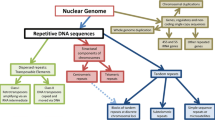Abstract
Two species of Ryukyu spiny rat, Tokudaia osimensis and Tokudaia tokunoshimensis, have an XO/XO sex chromosome constitution with no cytogenetically visible Y chromosome in both sexes. The single X chromosomes of T. osimensis and T. tokunoshimensis are submetacentric and subtelocentric, respectively. It was therefore suggested that a pericentric inversion event occurred in the X chromosome of either species. To identify X chromosome rearrangements that have occurred between the two species, we mapped 22 mouse cDNA clones of the X-linked genes on the chromosomes of the two species by direct R-banding FISH. The gene orders of the X chromosomes were conserved in the two species, whereas the position of the centromere on the X chromosome was different. This result indicates that the rearrangement which occurred in either of the X chromosomes after the two species diverged from a common ancestor involved not pericentric inversion but centromere repositioning.
Similar content being viewed by others
References
Arakawa Y, Nishida-Umehara C, Matsuda Y, Sutou S, Suzuki H (2002) X chromosomal localization of mammalian Y-linked genes in two XO species of the Ryukyu spiny rat. Cytogenet Genome Res 99: 303–309.
Carbone L, Nergadze SG, Magnani E et al. (2006) Evolutionary movement of centromeres in horse, donkey, and zebra. Genomics 87: 777–782.
Everts-van der Wind A, Kata SR, Band MR, Rebeiz M (2004) A 1463 gene cattle-human comparative map with anchor points defined by human genome sequence coordinates. Genome Res 14: 1424–1437.
Fredga K (1988) Aberrant chromosomal sex-determining mechanisms in mammals, with special reference to species with XY females. Phil Trans R Soc Lond B Biol Sci 322: 83–95.
Honda T, Suzuki H, Itoh M (1977) An unusual sex chromosome constitution found in the Amami spinous country-rat, Tokudaia osimensis osimensis. Jpn J Genet 52: 247–249.
Honda T, Suzuki H, Itoh M, Hayashi K (1978) Karyotypical differences of the Amami spinous country-rats, Tokudaia osimensis osimensis obtained from two neighboring islands. Jpn J Genet 53: 297–299.
Joseph AM, Chandley AC (1984) The morphological sequence of XY pairing in the Norway rat Rattus norvegicus. Chromosoma 89: 381–386.
Kasai F, Garcia C, Arruga MV, Ferguson-Smith MA (2003) Chromosome homology between chicken (Gallus gallus domesticus) and the red-legged partridge (Alectoris rufa); evidence of the occurrence of a neocentromere during evolution. Cytogenet Genome Res 102: 326–330.
Kobayashi T, Yamada F, Hashimoto T et al. (2007) Exceptional minute sex-specific region in the XO mammal, Ryukyu spiny rat. Chromosome Res 15: 175–187.
Koller PC, Darlington CD (1934) The genetical and mechanical properties of the sex chromosomes. I. Rattus norvegicus, O. J Genet 29: 159–173.
Kuroiwa A, Watanabe T, Hishigaki H et al. (1998) Comparative FISH mapping of mouse and rat homologues of twenty-five human X-linked genes. Cytogenet Cell Genet 81: 208–212.
Kuroiwa A, Tsuchiya K, Watanabe T et al. (2001) Conservation of the rat X chromosome gene order in rodent species. Chromosome Res 9: 61–67.
Malik HS, Henikoff S (2003) Conflict begets complexity: the evolution of centromeres. Curr Opin Genet Dev 12: 711–718.
Matsuda Y, Chapman VM (1995) Application of fluorescence in situ hybridization in genome analysis of the mouse. Electrophoresis 16: 261–272.
Matsuda Y, Harada Y-N, Natsuume-Sakai S et al. (1992) Location of the mouse complement factor H gene (cfh) by FISH analysis and replication R-banding. Cytogenet Cell Genet 61: 282–285.
Nagaki K, Cheng Z, Ouyang S et al. (2004) Sequencing of a rice centromere uncovers active genes. Nature Genet 36: 138–145.
Nakamura T, Kuroiwa A, Nishida-Umehara C et al. (2007) Comparative chromosome painting map between two Ryukyu spiny rat species, Tokudaia osimensis and Tokudaia tokunoshimensis (Muridae, Rodentia). Chromosome Res 15: 799–806.
Nesterova TB, Duthie SM, Mazurok NA et al. (1998) Comparative mapping of X chromosomes in vole species of the genus Microtus. Chromosome Res 6: 41–48.
Oakenfull EA, Lim HN, Ryder OA (2000) A survey of equid mitochondrial DNA: Implication for the evolution, genetic diversity and conservation of Equus. Conserv Genet 1: 341–355.
Soullier S, Hanni C, Catzeflis F, Berta P, Laudet V (1998) Male sex determination in the spiny rat Tokudaia osimensis (Rodentia: Muridae) is not Sry dependent. Mamm Genome 9: 590–592.
Sutou S, Mitsui Y, Tsuchiya K (2001) Sex determination without the Y chromosome in two Japanese rodents Tokudaia osimensis osimensis and Tokudaia osimensis spp. Mamm Genome 12: 17–21.
Suzuki H, Iwasa MA, Ishii N, Nagaoka H, Tsuchiya K (1999) The genetic status of the insular populations of the endemic spiny rat Tokudaia osimensis (Rodentia, Muridae) of the Ryukyu Islands, Japan. Mamm Study 24: 43–50.
Tsuchiya K, Wakana S, Suzuki H, Hattori S, Hayashi Y (1989) Taxonomic study of Tokudaia (Rodentia: Muridae): I. Genetic differentiation. Memoirs Natl Sci Museum, Tokyo 22: 227–234.
Tyler-Smith C, Gimelli G, Giglio S et al. (1999) Transmission of a fully functional human neocentromere through three generations. Am J Hum Genet 64: 1440–1444.
Ventura M, Archidiacono N, Rocchi M (2001) Centromere emergence in evolution. Genome Res 11: 595–599.
Ventura M, Weigl S, Carbone L et al. (2004) Recurrent site for new centromere seeding. Genome Res 14: 1696–1703.
Author information
Authors and Affiliations
Corresponding author
Rights and permissions
About this article
Cite this article
Kobayashi, T., Yamada, F., Hashimoto, T. et al. Centromere repositioning in the X chromosome of XO/XO mammals, Ryukyu spiny rat. Chromosome Res 16, 587–593 (2008). https://doi.org/10.1007/s10577-008-1199-5
Received:
Revised:
Accepted:
Published:
Issue Date:
DOI: https://doi.org/10.1007/s10577-008-1199-5




